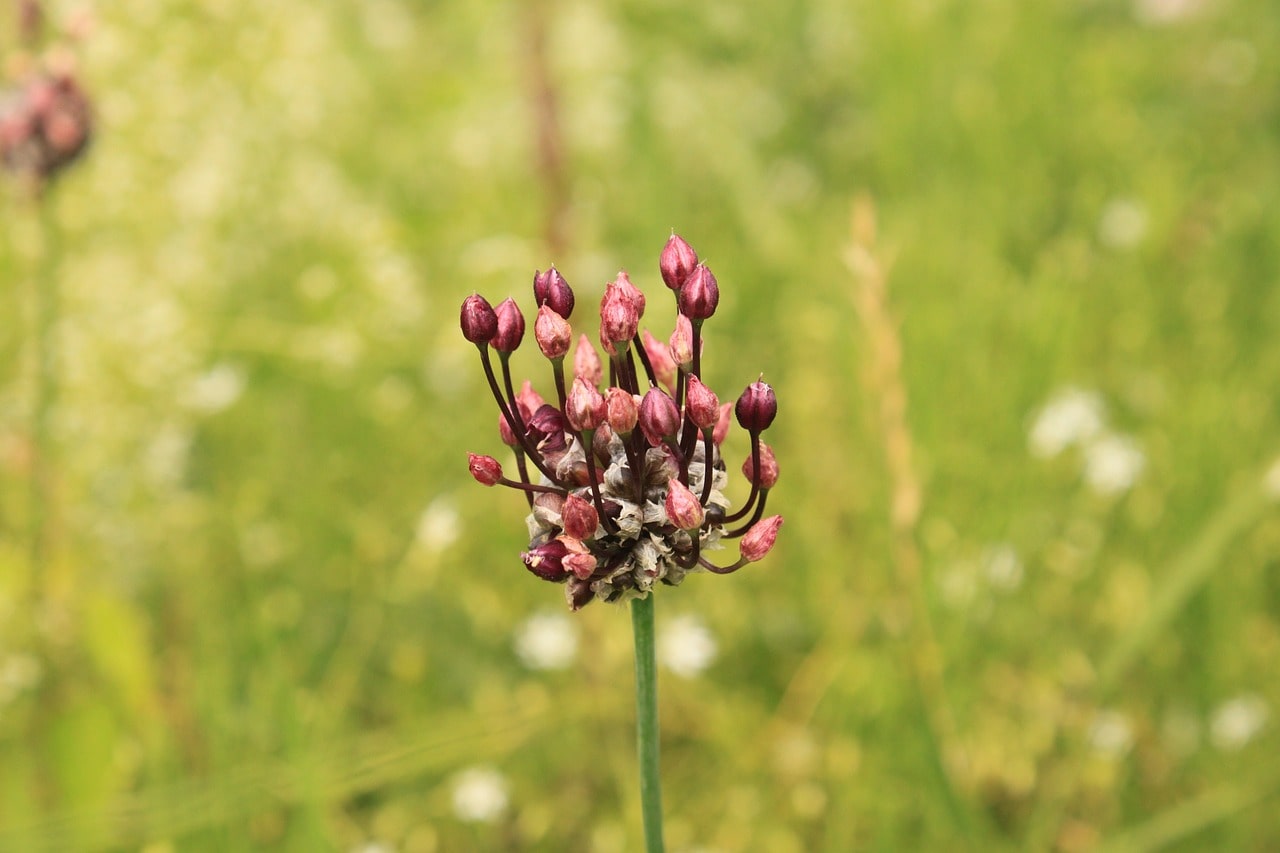Would you be interested in cultivating a plant that serves various purposes and offers numerous advantages? You would thrive with an Allium vineale. This annual bulb has several names besides “wild garlic,” but its anti-inflammatory and antioxidant qualities have made it famous. Also, it has the added benefit of being a natural barrier that keeps out pests.
Allium vineale, when planted in soil that has been adequately prepared, has the potential to be the showpiece of any garden. Reading on will provide you a lowdown on wild garlic’s benefits and how to keep it looking good. Indeed, I would be fully in favor of that. How about we take off?
Contents
General overview of allium vineale
Everyone knows that wild garlic, an evergreen bulbous perennial, is tough and lasts a long time. The typical height for this allium plant is 8 to 12 inches, and it typically only has one bloom head. Not only are these blooms visually appealing, but their greenish-white petals also form a star pattern when they unfold.
Bees play a crucial role in pollinating their flowers. With a spicy, oniony scent and a tiny, spherical bulb shape, wild garlic is easily recognizable.
Its native range is in Eurasia, but this plant has spread all over the world, even to the Americas. If you have the right spot and the soil is ready, it may transform any outside area into a stunning sanctuary. The anti-inflammatory and antioxidant characteristics of wild garlic make it a natural bug-repellent, and it also looks nice. There will also be refreshments available.
As expected, Allium vineale has long piqued the curiosity of antioxidant researchers. New evidence suggests that it protects cells from the oxidative stress that free radicals generate, a condition that can contribute to cancer and other illnesses. There is a lot of evidence that this plant can reduce inflammation. Thus, many people use it as a natural treatment for inflammatory diseases like arthritis.
The high sulfur content of wild garlic can ward off slugs and other pests. To get rid of pests in your home or yard without using harmful chemicals, this is a fantastic alternative to consider. Because it’s a multipurpose bulbous plant, consider adding it to your kitchen or yard immediately.
Soil preparation and planting instructions
The soil you use for planting wild garlic is just as crucial as the bulbs themselves. Loamy soil that provides sufficient drainage is ideal for this perennial bulbous plant. Its pH and drainage should be between 6 and 7.5.
When frost is unlikely, sow the wild garlic in the early to mid-spring. Make holes that are 8 inches deep and spaced 8 to 10 inches apart. After inserting the bulbs into the apertures, dust them with the liberated dust. Following sowing, give your seedlings plenty of water.
Allium vineale that has just been planted has to have a constant moisture level maintained because too much or too little water might stress the plants and cause them to die early. Add some organic materials, such as bark chips or straw, to your soil’s mulch if it doesn’t retain enough moisture throughout the scorching summer months. Applying fertilizer to your wild garlic plants once or twice a season can also promote strong growth and blooms.
Follow these guidelines for planting and soil preparation to get the most out of your wild garlic, a versatile perennial flower.
Health benefits of allium vineale
Allium vineale is related to numerous potential health advantages. It is an excellent option for lowering cholesterol, enhancing cardiovascular health, and lowering the risk of several cancers because of its anti-inflammatory and antioxidant qualities. Its ability to reduce blood sugar levels is beneficial for people with diabetes as well.
Beyond its medicinal applications, wild garlic is a helpful natural cure for skin diseases due to its antibacterial and antifungal properties. As a bonus, it can alleviate skin irritations and reduce swelling from bug bites and stings. Because of this, it is perfect for usage in cosmetics and OTC remedies such as eye makeup and skin care products.
Vital for healthy bodily processes, the plant is rich in magnesium, potassium, and vitamins A, C, E, and K. A healthy immune system, better digestion, and overall well-being are all positively impacted by these minerals. In fact, consuming wild garlic on a regular basis may aid in the prevention of common illnesses like the flu and colds and facilitate a speedier recovery if you do become sick.
The multipurpose wild garlic is a great plant to have on hand in the garden or the kitchen. This versatile bulbous plant has the potential to provide numerous health benefits for your body all year round, provided that you follow planting instructions and prepare the soil properly.
Culinary uses of allium vineale
In the kitchen, wild garlic has a wide variety of uses. Among the many uses for this versatile plant is as a garnish or to impart a delicate onion taste to dishes.
Allium vineale is a popular ingredient in salsa. Finely chop the petals and leaves and include them in the mixture for an extra burst of flavor. For an additional crunch and flavor punch, toss the leaves into stir-fries or salads. Pickling or adding the bulbs to soups and stews will bring out their full flavor.
As a houseplant or garden accent, wild garlic is ideal because of how easy it is to care for. This resilient perennial flower should produce flowers for a long time if planted precisely as directed. Wild garlic thrives on well-drained soil with a pH of 6.5 to 6.5 and is mulched with organic materials for optimal development.
Other favorable conditions include frequent irrigation. Year after year, you can anticipate abundant crops by following these measures!
Allium vineale is an excellent option if you are looking for a novel seasoning method that will not be too dominant in flavor. Its mild flavor is ideal for subtly seasoning meals without making them taste overpowering, and it also has nutritional and medicinal benefits. In addition to these benefits, it also has antioxidant and anti-inflammatory properties. Wild garlic is a very versatile plant with many uses in the kitchen.
Pest control with allium vineale
If you want to keep rats out of your garden, use allium finale as a pest deterrent. The strong scent of wild garlic naturally puts off aphids, caterpillars, and other little pests. Planting wild garlic next to your vegetable crops will deter these insects from visiting your plants. Plus, the garden benefits from the presence of helpful insects drawn to the nectar that allium vineale blooms provide, such as lacewings and ladybugs.
It is also possible to successfully control pests by planting Allium vineale with other plants, such as basil or roses. “Companion planting” describes this method. By studying the interplay between plants and making use of their unique characteristics, this gardening style helps you create a more stable garden ecology that deters pests while feeding beneficial insects.
A very efficient agricultural technique, companion planting allows you to grow multiple crops in one area, making better use of your available space.
Allium vineale’s anti-inflammatory and antioxidant qualities result in numerous additional health advantages beyond its usefulness as an insect repellant. In addition to the vitamins A, C, E, and K, it is rich in magnesium and potassium. Consuming these minerals on a regular basis helps boost immunity, facilitate better digestion, and promote general health.
Allium vineale, to put it briefly, is a multipurpose perennial bulbous plant that has several health advantages when used topically for skin ailments, including eczema and acne. Grown simply at home in any kitchen or garden for maximum benefit, with the proper preparation of the soil and planting instructions. As an insect repellant, it works wonders too.
Conclusion
To sum up, Allium vineale is a valuable and unusual plant that you may grow in your kitchen or backyard. Allium vineale, with its antioxidant and anti-inflammatory qualities, may flourish in any kitchen or garden with the proper care and guidance.
It’s also linked to a host of other health advantages. It is even more delicious when diced and added to stir-fries, salad dressings, soups, stews, and salsas. Furthermore, it has insect-repelling qualities.
The abundance of vitamins and minerals found in allium vineale can also support general health and immunity when taken regularly. We strongly advise readers to try growing allium vineale themselves in order to benefit from this magnificent plant’s many benefits fully.











3 thoughts on “The Benefits of Planting Allium Vineale”